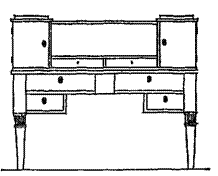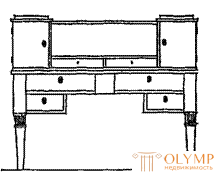
In the Russian architecture of the second third of the XIX century. reflects the complex interweaving of different directions. In architecture and arts and crafts decline begins.
Next to the classicist decisions, eclectic solutions appear in which stylistic unity is lost: in the same building (for example, in the Grand Kremlin Palace in Moscow, the Mariinsky, Novo-Mikhailovsky Palaces in St. Petersburg) the rooms are decorated in different styles: Gothic, Moorish, Pompeian. At the same time, the technical implementation of the redwood works was distinguished by high skill. So, in the Grand Kremlin Palace in Moscow (1838–1849, K. A. Thon), the Mariinsky Palace in St. Petersburg (1839–1845, A. I. Shtakenshneider) have unique pieces of wood carving.
In the Kremlin Palace, the doors are made of solid walnut, Caucasian plane tree, rosewood and decorated with intricate carvings combined with inlay. Parts of them are composed without the use of glue so that they are invisible. Parquets from a large number (from 20 to 60) of various wood species are distinguished by an unusually thin combination of color shades. In the furniture of many rooms there is a strong imitation of the rococo style. Upholstered chairs, armchairs, sofas are equipped with gilded carved details, covered with patterned silk and brocade fabrics.

Fig. 1. Mahogany desk-bureau (circa 1810)
In the halls of the Mariinsky and Winter Palaces (designed by A. P. Bryullov and V. P. Stasov) the furniture is made in the style of classicism, but more heavy and overloaded.
The first in time of appearance retrospective style of the XIX century. was pseudo-gothic, i.e. the use of gothic decor motifs. One of the typical examples of this trend is the interiors of the cottage of the architect A. Menelaus for Nicholas I in Alexandria from Peterhof (1827-1829). The principal innovation is the emergence of a special dining room.
Earlier in the XVIII - early XIX century. dined either in the office, or - with large receptions - in the ceremonial halls. Of particular interest is the solution to the interior of the bedroom. The walls, furniture upholstery and curtains are made of chintz, which indicates the increasing role of this material in the interior. The double bed is moved by the headboard to the wall and separated from the rest of the room by screens. At the feet is a covered basket for storing pillows.
Residential interiors of that time are characterized by restraint and moderation of decoration and are close to the European style of Biedermeier, differing from it only by greater warmth and polychrome. Furniture products become easier and more intimate, their size decreases, the form is facilitated. The thread is performed in the same material as the object itself. The finish is dominated by varnishing. From cladding materials prefer rosewood, dark walnut, ebony and its imitation. Some products are encrusted with metal and tortoise. For the upholstery they continue to use motley silk with textured ornament, striped chintz with bouquets, wool with embroidery, velvet, plush, leather. Often, furniture items include colored glass elements, invented aniline dyes are used for finishing.
The main feature of the interior of this period is smooth walls covered with glue paint, a few paintings, portraits, watercolors in edging or framed in mahogany or Karelian birch with dark squares at the corners. They began to arrange furniture in residential premises differently than at the beginning of the 19th century. The whole space was filled in the same way, without allocating the central part with headsets or selected two or three objects. The interior is divided into cozy corners.
From the middle of the XIX century. in Russia, Viennese furniture comes into being, the main structural element of which is a curved thin section rod made of beech wood and plywood parts or a grass net woven by machine. The desire for comfort and diversity often led to a glut of rooms with soft furniture, various tables, cabinets, shelves, dressers. Doors and windows were decorated with heavy curtains and draperies, numerous paintings were placed on the walls - landscapes, portraits, photographs, reproductions of works of art in various frames. Widely used tablecloths. In the interiors, an increasing role is played by the greenery, which either forms a trellis — green hedges, or it is shaped into bushes. A large number of special flower stands (jardinieres) appear in the interior.
From the middle of the XIX century. developing art manufacturing industry. The number of firms manufacturing interior items is growing rapidly. There are new factories and workshops. Specialized stores are opening, which have begun to replace the sale of products directly in the workshops. And in the shops they sold not only finished, but also white products, i.e., without finishing, as well as individual parts. The buyer could order the finishing of the product to your liking, for example, to choose a backrest to the frame of the chair, call the upholsterer to the house, etc.
Since 1829, the All-Russian exhibitions of the art manufacturing industry in St. Petersburg and Moscow were systematically held (once every two or three years), where products of Russian companies were displayed.
From the middle of the XIX century. begins to develop the science of furniture. Conducted the first study of the dependence of the size of furniture from its functions. On their basis, the curve of the back of the furniture for sitting was found, the basic dimensions of the products were determined. A lot of books are published, specially devoted to woodworking and furniture art, in which technological processing of wood is described in detail and at a sufficiently high level, and information about materials is reported.
However, eclecticism in architecture and furniture, which arose in the 30–50s of the 19th century, continues to develop and reaches its highest development in the 60–80s.
Что бы оставить комментарий войдите
Комментарии (0)